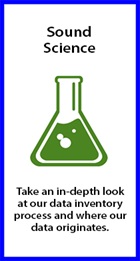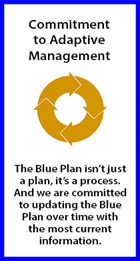Long Island Sound Blue Plan
The Long Island Sound Blue Plan has been approved and is now in effect!
Click to view the What's NEW section below.
 The Long Island Sound Blue Plan provides an inventory of the natural resources and uses of Connecticut's Long Island Sound and establishes a spatial plan to guide future use of the Sound's waters and submerged lands. The purpose of the Blue Plan is to facilitate a transparent, science-based decision-making process for the preservation of Long Island Sound's ecosystems and resources and the protection of traditional uses, while maximizing their compatibility and minimizing conflicts between them now and in the future. Click on the Blue Plan logo to learn the background of the Long Island Sound Blue Plan.
The Long Island Sound Blue Plan provides an inventory of the natural resources and uses of Connecticut's Long Island Sound and establishes a spatial plan to guide future use of the Sound's waters and submerged lands. The purpose of the Blue Plan is to facilitate a transparent, science-based decision-making process for the preservation of Long Island Sound's ecosystems and resources and the protection of traditional uses, while maximizing their compatibility and minimizing conflicts between them now and in the future. Click on the Blue Plan logo to learn the background of the Long Island Sound Blue Plan.
 The process for the development of the Blue Plan included two major steps:
The process for the development of the Blue Plan included two major steps:
- Gather data to develop an inventory of natural resources and human uses. This is done through the development of maps that are reviewed by experts and stakeholders for accuracy.
- Use those maps to develop a participatory process to map current and potential new uses in a manner that will minimize conflict with natural resources and traditional uses.
Throughout the development of the Plan, the Blue Plan team hosted three public hearings as required by the Blue Plan statute, held additional public meetings to share information and solicit input, and engaged countless experts and stakeholders through webinars and participatory mapping exercises. The result is a Blue Plan for Long Island Sound based on sound science and shaped by meaningful public input. The First Draft of the Long Island Sound Blue Plan was available for public review and comment between March 20, 2019 and June 21, 2019. The Final Draft of the Plan, submitted to the Connecticut General Assembly's Environment Committee before the start of the legislative session on February 5, 2020, includes the updated Long Island Sound Resource and Use Inventory (version 1.4 September 2019). The Blue Plan Map Viewer, developed in collaboration with the University of Connecticut’s Center for Land Use Education and Research, is a mapping tool that contains all of the Blue Plan's inventory data in an interactive format, allowing users to explore the Blue Plan's maps in more detail. You can also view the Long Island Sound Ecologically Significant Areas Story Map, which navigates and explains some of the interactive maps of the Long Island Sound Blue Plan Significant Areas available in the Blue Plan Map Viewer. Another public outreach tool developed for the Blue Plan is the Long Island Sound Blue Plan Video Series. The series is a collection of six videos about the Blue Plan, featuring interviews with Blue Plan Advisory Committee members, ecological experts, and other sector representatives on the topics of the Blue Plan in general, ecologically significant areas, commercial fishing and aquaculture, cultural and historic features, recreation, and transportation and infrastructure. The video series was produced with Middlesex Community College to provide background about the Blue Plan that is both in-depth and easy to understand. The Blue Plan process is informed by guiding principles that include meaningful public participation, sound science, a transparent process, coordination and collaboration, and a commitment to adaptive management.
Select each image below to link to more information.
What's New
- On February 11, 2022, the National Oceanic and Atmospheric Administration's Office for Coastal Management approved Connecticut's request for a program change to incorporate Blue Plan enforceable policies into the state's coastal management program. As of that date, the enforceable policies identified in the Table of Approved Changes shall be applicable in reviewing federal actions pursuant to the federal consistency requirements of the CZMA and its implementing regulations found at 15 CFR part 930.3.
- Commissioner Dykes' 2021 Blue Plan Transmittal Letter to the CGA Environment Committee
- The Blue Plan Development Team has created a Story Map of the Significant Human Use Areas of Long Island Sound (SHUAs), which are described in the Long Island Sound Blue Plan, to help navigate and explain the vast amount of data assembled to map these areas of uses of the Sound that have a significant role in the social, cultural, historic, economic, and quality of life of Long Island Communities.
- The Blue Plan Practitioners Guide is a supplement to the Long Island Sound Blue Plan and the Blue Plan Users Guide, and provides an overview of the myriad ways the Blue Plan can benefit users of and interests in the Sound outside the context of regulatory guidance.
- The Blue Plan Users Guide is now available. The guide is a companion to the Long Island Sound Blue Plan and is intended to assist readers in easily finding, understanding, and applying the information, policies, and tools provided by the Plan.
- Commissioner Dykes' Blue Plan Transmittal Letter to CGA Environment Committee
- The Blue Plan Development Team has created a Story Map of the Long Island Sound Ecologically Significant Areas (ESAs), which are described in the Long Island Sound Blue Plan, to help navigate and explain the huge amount of data assembled to map ESAs in Long Island Sound.
Content Last Updated December 4, 2025






